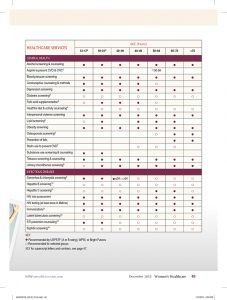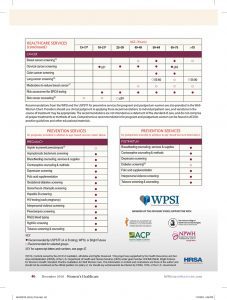Preventive care visits provide an excellent opportunity for well-woman care, including screening, evaluation of health risks and needs, counseling, and immunizations. Recommendations for Well-Woman Care – A Well-Woman Chart was developed by the Women’s Preventive Services Initiative (WPSI).
The Well-Woman Chart outlines preventive services recommended by the WPSI, U.S. Preventive Services Task Force (USPSTF), and Bright Futures based on age, health status, and risk factors. Additional recommendations for immunizations are provided in a separate table from the Advisory Committee on Immunization Practices. Clinical practice considerations, risk assessment methods, and the age and frequency to deliver services are described in the Clinical Summary Tables that accompany the chart.
The Recommendations for Well-Woman Care – A Well-Woman Chart provides a framework for incorporating preventive health services for women into clinical practice. These services may be completed at a single visit or as part of a series of visits that take place over time. The recommendations are not intended as a statement of the standard of care, and do not comprise all proper treatments or methods of care. Providers should use clinical judgment in applying these recommendations to individual patient care, taking into account the needs and resources particular to the locality, the institution, or the type of practice. The Chart is updated annually. The WPSI website (womenspreventivehealth.org) has the most up-to-date version of the Chart and Clinical Summary Tables.



- Additional Bright Futures recommendations include: Periodic vision and hearing tests for ages 13-21; risk assessment for anemia for ages 13-21; and fluoride supplementation if needed for ages 13-16 (brightfutures.aap.org/Bright%20Futures%20Documents/Screening.pdf). Recommendations on services for adolescents under the age of 13 can be found at aap.org/.
- Immunizations should be administered according to the most recent ACIP recommendations (cdc.gov/vaccines/schedules/index.html).
Abbreviations:
ACIP = Advisory Committee on Immunization Practices; BRCA = breast cancer susceptibility gene; CRC = colorectal cancer; CVD = cardiovascular disease; HIV = human immunodeficiency virus; HCV = hepatitis C virus; HBV = hepatitis B virus; STI = sexually transmitted infection; USPSTF = U.S. Preventive Services Task Force; WPSI = Women’s Preventive Services Initiative.
*Criteria for selective screening
- Low-dose aspirin to prevent cardiovascular disease and colorectal cancer: Calculated 10-year risk of a CVD event ≥10%; not at increased risk for bleeding; have a life expectancy of at least 10 years; and are willing to take low-dose aspirin daily for at least 10 years.
- Diabetes screening and management: Overweight or obese for age 40-70 years; previous gestational diabetes, but not previously diagnosed with diabetes mellitus when not pregnant for age ≥13 years.
- Folic acid supplementation: Sexually active and planning or capable of pregnancy.
- Healthful diet and physical activity counseling: Overweight or obese and have additional CVD risk factors (hypertension, dyslipidemia, abnormal blood glucose levels, diabetes).
- Lipid screening: Familial dyslipidemia, risk factors, or high-risk conditions for age 13-17 years.
- Osteoporosis screening: 10-year fracture risk equivalent to an average-risk 65-year-old woman based on specific risk factors (parental history of hip fracture, smoking, white race, excess alcohol consumption, low body weight).
- Statin use to prevent CVD: Age 40 to 75 years; one or more CVD risk factors (i.e., dyslipidemia, diabetes, hypertension, or smoking); and calculated 10-year risk of a CVD event ≥10%.
- Urinary incontinence screening: Screen all women age 18 or older and younger women if postpartum.
- Gonorrhea and chlamydia screening: New sex partner, more than one sex partner, a sex partner with concurrent partners, or a sex partner who has an STI; inconsistent condom use among persons who are not in mutually monogamous relationships; previous or coexisting STI; and exchanging sex for money or drugs. Prevalence is also higher among incarcerated populations, military recruits, and patients receiving care at public STI clinics.
- Hepatitis B screening: Born in a country with a prevalence of HBV infection ≥2%; lack of vaccination in infancy in U.S.-born persons with parents from a country or region with prevalence ≥8%; HIV-positive persons; injection drug users; and household contacts or sexual partners of persons with HBV infection.
- Hepatitis C screening: One-time screening for adults born between 1945 and 1965. Criteria for others includes past or current injection drug use; receipt of a blood transfusion before 1992; long-term hemodialysis; born to an HCV-infected mother; incarceration; intranasal drug use; getting an unregulated tattoo; and other percutaneous exposures (e.g. healthcare workers).
- Latent tuberculosis infection: Persons from countries with increased tuberculosis prevalence; living in high-risk congregate settings (e.g., homeless shelters, correctional facilities); exposure to individuals with active tuberculosis, such as healthcare workers and workers in high-risk congregate settings; immunosuppressed individuals.
- Sexually transmitted infection prevention counseling: New sex partner, more than one sex partner, a sex partner with concurrent partners, or a sex partner who has an STI; inconsistent condom use among persons who are not in mutually monogamous relationships; previous or coexisting STI; and exchanging sex for money or drugs. Prevalence is also higher among incarcerated populations, military recruits, and patients receiving care at public STI clinics.
- Syphilis screening: Women with HIV; high-prevalence communities or populations; history of incarceration; exchanging sex for money or drugs.
- Breast cancer screening: No specific criteria; decisions about screening are made on an individual basis through a shared decision-making process.
- Lung cancer screening: 30-pack-year smoking history and currently smoke or have quit within the past 15 years.
- Medications to reduce breast cancer risk: Major risk factors for breast cancer include increasing age, family history of breast or ovarian cancer (especially among first-degree relatives and onset before age 50 years), history of atypical hyperplasia or other nonmalignant high-risk breast lesions, previous breast biopsy, and extremely dense breast tissue. Models suggest that women with an estimated 5-year breast cancer risk of 3% or greater are likely to have more benefit than harm, although the balance depends on age, race, or ethnicity, the medication used, and whether the patient has a uterus.
- Skin cancer counseling: Fair skin, light hair and eye color, freckles, sunburn easily.
- Low-dose aspirin to prevent preeclampsia: History of preeclampsia, especially when accompanied by an adverse outcome; multifetal gestation; chronic hypertension; type 1 or 2 diabetes mellitus; renal disease; autoimmune disease (systemic lupus erythematosus, antiphospholipid syndrome).
- Diabetes screening after pregnancy: Previous gestational diabetes, but not previously diagnosed with diabetes mellitus when not pregnant.

